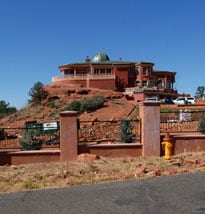Forget the sewer. We want storm drains. That’s what some residents in the Chapel area are saying. The Sedona City Council’s decision on Oct. 23 to spend $7.4 million on sewers for the area is making some people fume.
Larson Newspapers
Forget the sewer. We want storm drains.
That’s what some residents in the Chapel area are saying.
The Sedona City Council’s decision on Oct. 23 to spend $7.4 million on sewers for the area is making some people fume.
“Most of the residents here have perfectly good septics with expected working lifespans of many, many years,” said Bruce Wymore, who built his home on Cathedral Road eight years ago.
“Spending millions of dollars on the sewer system is unnecessary and will lead to destruction of our neighborhoods for months on end. Scarce city resources should be spent on something we all need, which is stormwater drainage,” Wymore said.
Although the city conducted a survey of Chapel residents, only a fraction responded, making Wymore believe that the council’s decision on the sewer project was a “done deal” made regardless of the desires of homeowners.
Wymore also questions whether the city has budgeted adequate funds for the sewer.
“Rock is hard to trench through,” Wymore said. “Is $7.5 million really enough?”
Bob Hargrove built his home on Lynx Drive in 1994 and is all for the sewer.
However, he agrees with Wymore that storm drains should be a priority or, preferably, installed at the same time as the sewers.
Living beside a wash that becomes a creek during storms, Hargrove says he’s repeatedly asked the city for help after heavy rains.
When the city responded that it had no money in the budget for remediation, Hargrove says he spent hundreds of his own dollars to fill the ever-deepening ditch with dump truck loads of rock.
When the storm this past July dispatched — for the third time — all the rocks he’d purchased, including some that weighed 72 pounds, he gave up.
“I told the city it was their problem now,” Hargrove said.
That same storm sent a river of mud toward Wymore’s home, washing away plantings, rock and topsoil.
In preparation for the next deluge, Wymore leveed the border of his property with sandbags in an effort to prevent further damage.
Another neighbor’s damage was worse.
“July’s storm was the third time in five years that we’ve had water coming into the house,” Jack Bartolini said. “It flowed through the bedroom, kitchen and storeroom.”
Located on the east side of Hwy. 179, the Chapel area is a cluster of old and new neighborhoods nestled at the base of a semi-circle of towering rock walls.
Historically, when the monsoon dumps heavy rain on the area, water courses off this natural amphitheater of rock, leading to flash runoffs.
However, neighbors say that serious flooding has increased since construction of a large home on top of Turtle Rock began five years ago.
The home has one small, square porthole that empties water from its vast flat roof onto slick rock below it.
At first glance, it appears the 12,000-square-foot house is the culprit, however, John O’Brien, director of community development for Sedona, says the house meets every city standard and has no variances issued for it.
The real problem seems two-fold.
For one, many of the old, shallow drainage ditches, installed years ago when the area was maintained by Coconino County, haven’t been enlarged to keep up with development.
A prime example is the short length of storm drain on Cathedral Road that now receives increased flow from the house on Turtle Rock.
Part of the ditch was widened and deepened by the city, but it empties into an old unimproved ditch which is narrow and shallow.
Instead of water temporarily sheeting Cathedral Road, which is what residents say happened in the past, heavy rains now send flood waters and debris cascading into neighboring homes and yards causing damage to buildings and landscaping and shutting down septic systems along the way.
In the absence of properly engineered storm drains, some homeowners have built their own channels and walls and ditches.
“The way development has occurred in the various neighborhoods, drainage has gradually been modified so that it no longer goes purely the way it might naturally want to go,” City Engineer Charles P. Mosley said.
Strolling through one neighborhood, it’s easy to see the individual remedies homeowners have adopted to deal with their drainage.
One home has a pink dimpled gunite sluice, another a green ivy-covered ditch.
Still others have made architectural features of their channels, using professionally-laid stonework.
And some just have dirt.
Not everyone living in the shadow of the Chapel of the Holy Cross is suffering.
Lois Anetzberger says she has no problem with storm drainage and her septic system works fine so she wants neither of the improvements to go forward.
Lin Ennis says she had serious stormwater problems until she spent thousands of dollars improving the ditch in front of her home.
Ennis believes the city should address the issue by developing a stormwater management plan.
“The plan should include what is and is not allowed in building walls, fences, moving ditches, deepening ditches,” Ennis said. “[It should] also adjust for how each new rooftop, driveway or deforested lot changes water flow.”
While some neighborhoods near the Chapel are on the docket to benefit from $1.9 million in stormwater work, most are not.
Even if city officials determine that the majority of residents don’t want sewers but did want drain work, the money earmarked for sewers is not transferable.
“Stormwater work is paid through capital funding,” City Manager Eric Levitt said. “Sewer funds are completely separate and we’re not allowed to move them to the drainage project.”
“We have five areas throughout Sedona that are due to have storm work,” Levitt said. “The most equitable process is to complete those four other projects as scheduled before looking at other areas in the Chapel.”
Work on the sewer and storm drains is scheduled to begin in late spring of 2008 and will take approximately 18 to 20 months to complete, Levitt said.






















